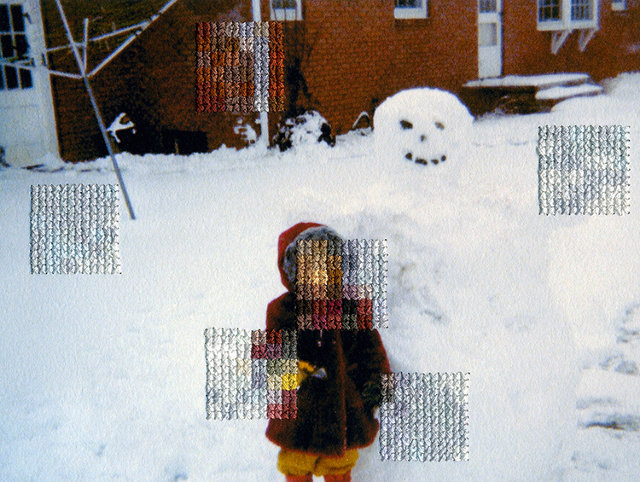In 2011, Diane Meyer's brother was hit by a car. His skull smashed in the accident, Meyer's brother needed to have a steel plate put in; even after the surgery, he was in a coma for several weeks. As Meyer worried about her brother, she looked through old family photographs and wondered: If her brother survived, would he remember them the way she did, or if would he just remember their shared past in patches, like a quilt that has worn away?
In the end, Meyer's brother fully recovered after several weeks, with no serious repercussions to his memory. Nevertheless, the experience left its mark upon both Meyer and her work. In Time Spent That Might Otherwise Be Forgotten, the artist modifies family photographs so that faces and details are blurred, as if they have been obscured by the censor of malfunctioning memory and mind.

In Meyer's work, she first goes through old family photographs of her childhood, and then embroiders them with needle and thread. The faces of Meyers and her brother sitting in a pumpkin patch, the two of them in front of a 1970s Christmas tree, a field of lilacs--all are pointilistically pixellated through cross-stitch embroidery. In a picture of a young Diane at Disneyworld, even the face of Donald Duck is obscured.
"The embroidery deteriorates the original photograph and forms a pixelated version of the underlying image," Meyer says. "Since large areas of the photographs are concealed by the embroidery, small, seemingly trivial details emerge, while the larger picture and context become erased."
All of Meyer's subject photographs come from her family archives, and were "probably" taken by her mother or another family member, she says. It can be difficult for Meyer to find images to use. This disconnect only emphasizes the intangible quality of memory and the ease with which it can be obscured or eradicated.

"These days, everyone has a camera in their pocket all the time, and you can take as many photos as you want quickly, easily and for free," Meyer tells Co.Design. "When I was growing up, though, my mother might go through a single roll of film in the camera for a year. There were maybe 20 photos per year. There are so many more gaps back then than there are now."
In Time Spent That Might Otherwise Be Forgotten, it isn't just gaps in the photographic record that are suspect. It's the photographic record itself. It's true, we live in the age of digital photography, when the average person is never without a camera. Even so, the millions of photographs we take every day will never be printed out to be saved in an album or a box. They will never be physical relics of the past, but memories of computers. Myer's work reminds us that they are just a stitch of time (or thread) away from being written over.
A solo exhibition of Meyer's work was on display recently at Griffin Museum of Photography in Boston.